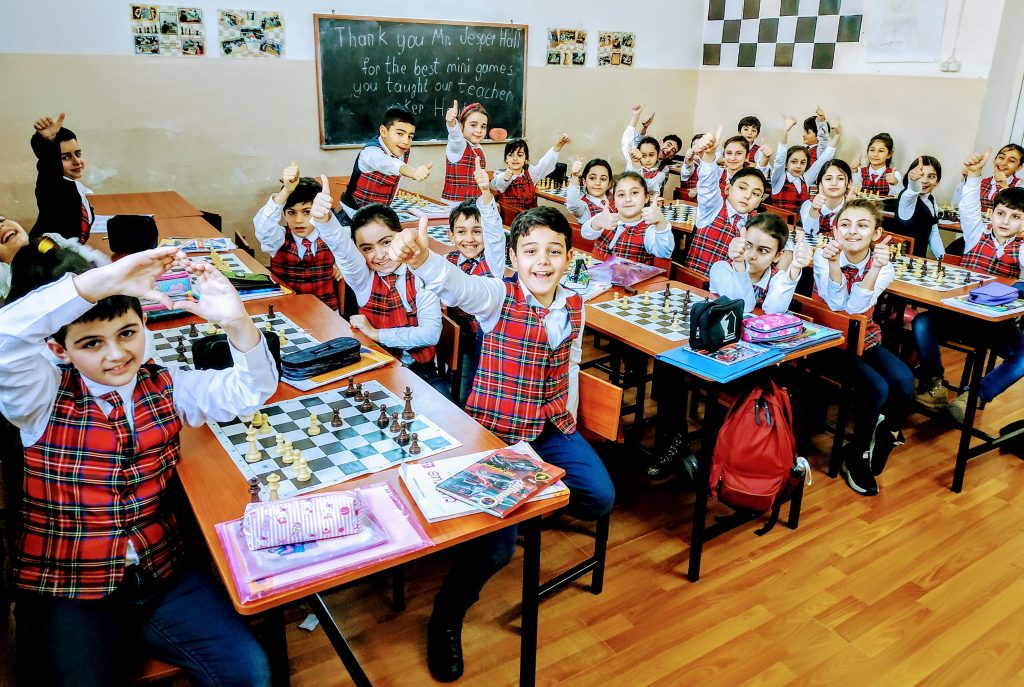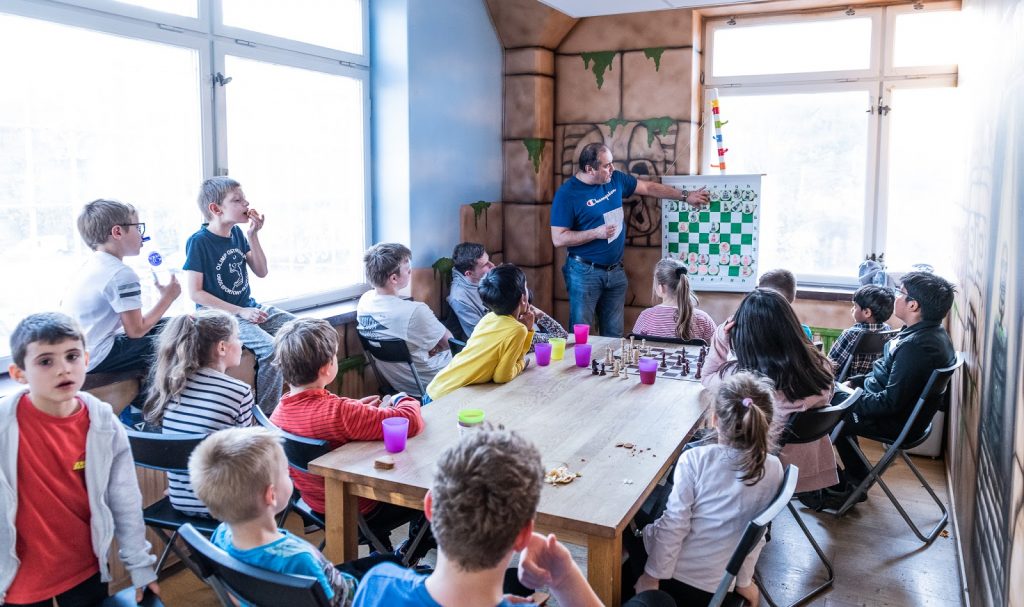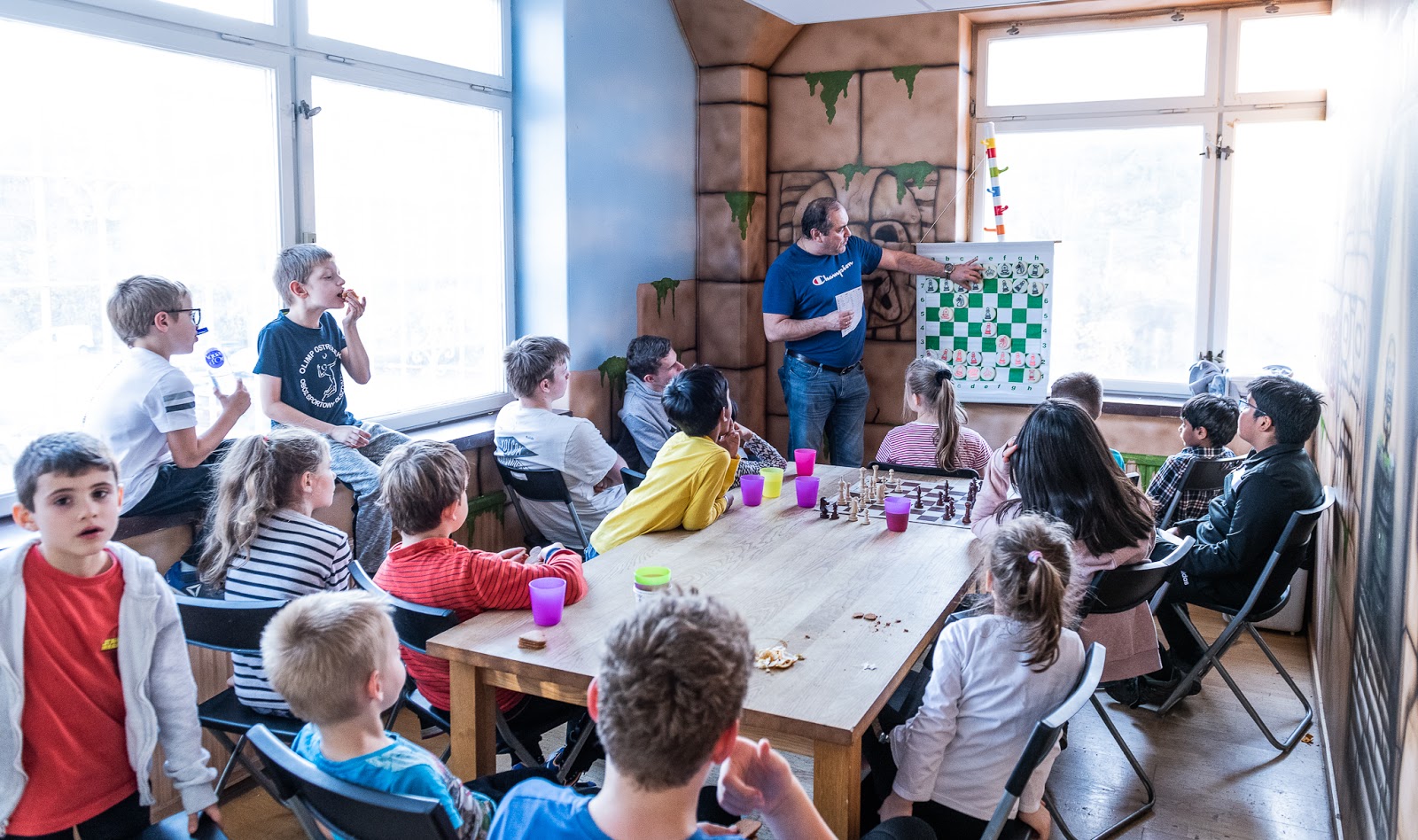Teachers are central to education. In primary schools, teachers must teach a range of different subjects. They need not be an expert in any of these subjects, but they need to know some basics. For example, in mathematics, they teach basics such as numbers, counting, shapes, simple graphs and so on. Lack of deep subject knowledge is rarely an issue. Teachers can always call upon resources to match their teaching styles and the children’s requirements. Teachers bring the most important skill – the ability to engage and instruct a class of children.
Children love playing games. They enjoy playing chess and may continue to do so throughout their lives. Irrespective of the depth of play, playing in itself is a rewarding experience. The level of play improves with practice. A short period of learning followed by a lifetime of pleasure. Chess should be regarded as part of an educated person’s range of skills.
Chess is regarded as the ultimate thinking game: it requires concentration, logical analysis and problem-solving. Research shows that chess improves school academic performance. See the dozen studies which are essential reading.
Traditionally games, as in boardgames, were only played when the children had to be kept indoors at lunchtime because it was raining. Not much attention was paid to whether or not there was any merit in teaching games. There are lots of games and the teachers could not be expected to learn the rules. Yet there is something special about games which was being missed – they are a fertile ground for cognitive activities. Surely this is what modern education is about – developing thinking skills. Chess has been selected by countless education authorities as the most appropriate vehicle for delivering for thinking skills.
Can games be taught? The didactics of teaching chess emerged gradually over the last few decades. Chess has in effect been decomposed into smaller elements which can be taught separately. This gave rise to the “Chess in Schools” movement which has been instrumental in rolling out classroom chess throughout the world.
So how to begin teaching it? Does the school need to hire a chess expert or can teachers include it in their repertoire? This article will argue that regular classroom teachers can be trained to teach chess. Furthermore, this is not an onerous task. In fact, it is fun to learn and very rewarding to teach.
The main point to note is that chess teaching needs to be done in a structured way. Teaching games-based subjects is different from teaching knowledge-based subjects. It is more like teaching physical education – there is a little bit of theory but a lot of practice is required. In order to explain why chess can be taught by non-experts, we need to examine the game from a historical perspective.
Chess is part of a family of games the rules of which evolved over centuries. Different versions of chess emerged in different continents. The European version of chess became pre-eminent especially after international competitions developed in the nineteenth century. We may refer to this form of the game as “orthodox” chess. It is played by millions of people and has an international governing body which sets the rules and regulates top level tournaments and the world championships.
Orthodox chess is treated more like a sport, or to be more precise, a mindsport. It is the ideal platform for competition. The rules are easy to learn and children can begin playing immediately. It is tempting to import this form of chess into schools. Competitive chess gives pupils the opportunity to shine. Playing in tournaments and against other schools strengthens the school profile in the same way as playing field sports. Many schools feature chess as a valuable extra-curricular activity on their literature and website.

There are natural limits to competitive chess at school. There is a wide range of chess abilities and some children will get bored of consistently winning or, conversely, losing. They need to play against those of roughly the same level. One way of achieving this is to use competition formats which ensure that those of similar ability play against each other. Even if they play those at the same level there comes a point where the narrow range of opponents does not present a sufficiently varied and exciting challenge. For this reason, competitive chess only retains the interest of a class of children for no more than a year or so. An after-school chess club, being self-selected, may take chess more seriously and often continues year after year.
The main objective is to provide valuable educational experience based around chess. Chess lessons are most effective if they are led by chess experts in conjunction with the classroom teacher. The ideal situation is that the expert focuses on the chess whereas the teacher facilitates the special game-learning environment. This teacher/expert model may be distinguished from the conventional approach whereby a single teacher presides over the whole class. The teacher/expert model can make significant progress both in terms of chess performance and also improvements in thinking skills. Moreover, this can be a route by which teachers learn how to teach chess – always useful for maintaining continuity.
The practical task is to find a chess tutor i.e. a chess expert who is available and who can teach the game. Finding and retaining chess tutors is not easy. Many people who are strong at chess have intellect enabling them to secure a career. However, there is a category of chess experts, namely titled players (e.g. Master) who have attained the highest level of playing ability and, having devoted themselves to the noble game, offer themselves as chess tutors. The question is whether in reaching the heights of chess performance they can still relate to beginners and intermediate players. Will they focus on the subtleties of the game rather than the pragmatics of teaching? For example, they may provide instruction on chess openings and endgame techniques. These improve the chances of winning for children who are able to absorb that level of detail. The danger is that this information will go over the head of most of the class.
A great skill possessed by teachers is the ability to imagine themselves in the position of the child. Children do not want lectures; they want to play. In order to encourage them to listen they need variety and surprise. They like stories. Teachers know how to wrap information into a story to make the topic come alive. This is a didactical technique which chess tutors will have to master.
There is a more fundamental concern about competitive chess. Put simply, the pursuit of victory can crowd out so many of the other wonderful aspects of chess. This is not a concern about competition in itself – after all the world is a competitive place. The concern is that competition is being foisted on children because there is a lack of awareness of the real nature of chess. The family of chess games have four elements in common: a gridded board, a set of pieces with defined moves, the rules of the game and the objective of the game. We can vary any of these elements and still have a game in the chess family. Once this is understood, then we can open the doors to a new form of activity to which, for these purposes, we can refer to as “Scholastic chess”. Scholastic refers to the educational purpose.
To illustrate what is meant by Scholastic chess, imagine varying each of the above four elements. You could play on a smaller board, perhaps 5×5 to make the game less challenging. The power of the pieces could be varied so that for example the queen also takes on the power of the knight. You could stipulate that the en passant rule does not apply. You could have alternative winning conditions e.g. capturing the king, or getting the king over the half-way line, or both. These few examples show that there is an unlimited number of chess-like games that can be constructed from just a few elements. This stimulates the imagination and encourages players to think in new ways. Being an expert at orthodox chess is no longer the prime qualification – what counts is flexibility and creativity of thought.
Scholastic chess uses the chess pieces and / or the chess board to facilitate a series of exercises including chess and logic puzzles and structured investigations. Mini-games and chess variants are also part of Scholastic chess. Mini-games use a subset of pieces – not the 32 used in orthodox chess. Chess variants have different rules and winning conditions.
To give an example, in Scholastic chess we could stipulate the winning condition to be the capture of the opponent’s king. This is a much easier concept to understand than checkmate. Teachers struggle to identify checkmate in a position. However, there is no doubt as to whether a king has been captured. Hence, it is much easier to teach chess with the king-capture objective. Competitive chess experts may be horrified but actually they have not understood the evolution of chess. In its early history, chess games were won by king capture. Checkmate is an elegant addition to the game, shortening the game by one move, but it does not actually change the nature of play.
Another classic chess variant is Loser’s Chess in which the objective is to lose all your pieces. This runs counter to the objective in orthodox chess but is nonetheless a legitimate game respected throughout the world. Some chess experts have a problem with Loser’s Chess because they believe it may lead to confusion in learning chess. This fear is unfounded and may be compared with the empty fear that learning a second language will lead to confusion with your first language. On the contrary, the changing the elements of play can undoubtedly bring greater the educational value.
Teachers who are chess experts tend to prefer competitive chess over Scholastic chess. The rules of chess may get a quick run-through in the first session, then the coaching moves at lightning speed onto advanced chess concepts. Most experts insist on all practice games being played with correct chess rules and they use game analysis as their main teaching tool. If they are not regular classroom practitioners then they are likely to focus on students who can already play some good chess, hoping that the rest will catch up somehow. These coaches see chess as a sport and in sport the goal is to win – invariably at the cost of leaving some children behind.

Trained teachers who are not or who have not been competitive players themselves fare better at engaging a larger group of children in a variety of chess activities. They are open to approach chess instruction in the Scholastic way i.e. experiment with mini-games, chess variants and different investigations of the chess pieces and the chess board. These teachers may face challenges from a few students with questions like “When can we play proper chess?” or even more likely “When are we finally going to play in a tournament?”.
We can safely say that generally trained teachers fare better at delivering Scholastic chess while chess experts would be the first choice if chess instruction takes the form of competitive chess in the school.
All children love to play. Many children love to play chess if they are given the opportunity. They may have had some tuition at home and enjoy showing off their chess skills to their friends. Some are not very good at the game but enjoy it nevertheless. They are not really interested in improving their technique and they do not particularly care about the outcome of their game either – only about the opportunity to experience play and to have fun.
A few children love chess with a passion. They seize every opportunity for a game and they are determined to win at all costs. Some children are good at chess and not much else. Tears and emotions arise when something does not go to plan. They loathe losing, which by the way is one of the characteristics of professional chess players. Children in this category are more interested in competitive chess and gain considerable chess expertise in this way.
For the majority of children, Scholastic chess led by a teacher is the recommended method of instruction in schools. In addition to this, if resources permit, then chess as an optional extra-curricular activity would satisfy the need of those few children who want to take chess to a higher level. Ideally, this club should be run by a chess expert or a teacher with some experience in chess competitions.

